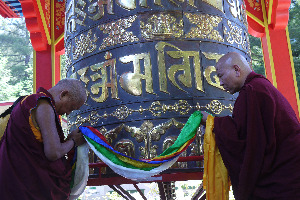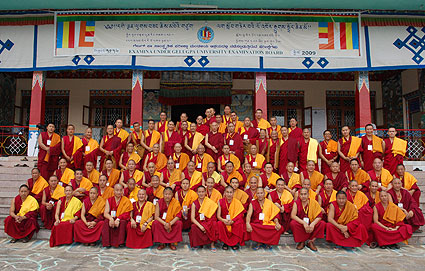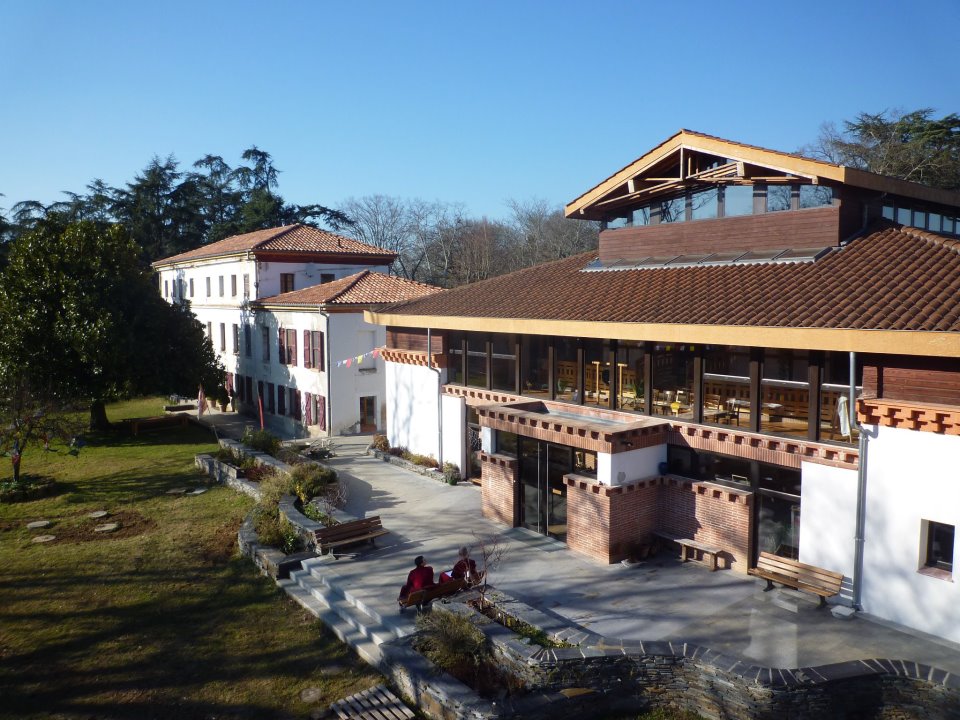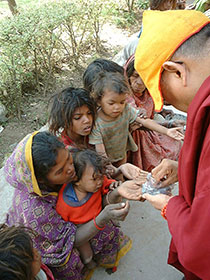- Home
- FPMT Homepage

Foundation for the Preservation of the Mahayana Tradition
The FPMT is an organization devoted to preserving and spreading Mahayana Buddhism worldwide by creating opportunities to listen, reflect, meditate, practice and actualize the unmistaken teachings of the Buddha and based on that experience spreading the Dharma to sentient beings. We provide integrated education through which people’s minds and hearts can be transformed into their highest potential for the benefit of others, inspired by an attitude of universal responsibility and service. We are committed to creating harmonious environments and helping all beings develop their full potential of infinite wisdom and compassion. Our organization is based on the Buddhist tradition of Lama Tsongkhapa of Tibet as taught to us by our founders Lama Thubten Yeshe and Lama Thubten Zopa Rinpoche.
- Willkommen
Die Stiftung zur Erhaltung der Mahayana Tradition (FPMT) ist eine Organisation, die sich weltweit für die Erhaltung und Verbreitung des Mahayana-Buddhismus einsetzt, indem sie Möglichkeiten schafft, den makellosen Lehren des Buddha zuzuhören, über sie zur reflektieren und zu meditieren und auf der Grundlage dieser Erfahrung das Dharma unter den Lebewesen zu verbreiten.
Wir bieten integrierte Schulungswege an, durch denen der Geist und das Herz der Menschen in ihr höchstes Potential verwandelt werden zum Wohl der anderen – inspiriert durch eine Haltung der universellen Verantwortung und dem Wunsch zu dienen. Wir haben uns verpflichtet, harmonische Umgebungen zu schaffen und allen Wesen zu helfen, ihr volles Potenzial unendlicher Weisheit und grenzenlosen Mitgefühls zu verwirklichen.
Unsere Organisation basiert auf der buddhistischen Tradition von Lama Tsongkhapa von Tibet, so wie sie uns von unseren Gründern Lama Thubten Yeshe und Lama Thubten Zopa Rinpoche gelehrt wird.
- Bienvenidos
La Fundación para la preservación de la tradición Mahayana (FPMT) es una organización que se dedica a preservar y difundir el budismo Mahayana en todo el mundo, creando oportunidades para escuchar, reflexionar, meditar, practicar y actualizar las enseñanzas inconfundibles de Buda y en base a esa experiencia difundir el Dharma a los seres.
Proporcionamos una educación integrada a través de la cual las mentes y los corazones de las personas se pueden transformar en su mayor potencial para el beneficio de los demás, inspirados por una actitud de responsabilidad y servicio universales. Estamos comprometidos a crear ambientes armoniosos y ayudar a todos los seres a desarrollar todo su potencial de infinita sabiduría y compasión.
Nuestra organización se basa en la tradición budista de Lama Tsongkhapa del Tíbet como nos lo enseñaron nuestros fundadores Lama Thubten Yeshe y Lama Zopa Rinpoche.
A continuación puede ver una lista de los centros y sus páginas web en su lengua preferida.
- Bienvenue
L’organisation de la FPMT a pour vocation la préservation et la diffusion du bouddhisme du mahayana dans le monde entier. Elle offre l’opportunité d’écouter, de réfléchir, de méditer, de pratiquer et de réaliser les enseignements excellents du Bouddha, pour ensuite transmettre le Dharma à tous les êtres. Nous proposons une formation intégrée grâce à laquelle le cœur et l’esprit de chacun peuvent accomplir leur potentiel le plus élevé pour le bien d’autrui, inspirés par le sens du service et une responsabilité universelle. Nous nous engageons à créer un environnement harmonieux et à aider tous les êtres à épanouir leur potentiel illimité de compassion et de sagesse. Notre organisation s’appuie sur la tradition guéloukpa de Lama Tsongkhapa du Tibet, telle qu’elle a été enseignée par nos fondateurs Lama Thoubtèn Yéshé et Lama Zopa Rinpoché.
Visitez le site de notre Editions Mahayana pour les traductions, conseils et nouvelles du Bureau international en français.
Voici une liste de centres et de leurs sites dans votre langue préférée
- Benvenuto
L’FPMT è un organizzazione il cui scopo è preservare e diffondere il Buddhismo Mahayana nel mondo, creando occasioni di ascolto, riflessione, meditazione e pratica dei perfetti insegnamenti del Buddha, al fine di attualizzare e diffondere il Dharma fra tutti gli esseri senzienti.
Offriamo un’educazione integrata, che può trasformare la mente e i cuori delle persone nel loro massimo potenziale, per il beneficio di tutti gli esseri, ispirati da un’attitudine di responsabilità universale e di servizio.
Il nostro obiettivo è quello di creare contesti armoniosi e aiutare tutti gli esseri a sviluppare in modo completo le proprie potenzialità di infinita saggezza e compassione.
La nostra organizzazione si basa sulla tradizione buddhista di Lama Tsongkhapa del Tibet, così come ci è stata insegnata dai nostri fondatori Lama Thubten Yeshe e Lama Zopa Rinpoche.
Di seguito potete trovare un elenco dei centri e dei loro siti nella lingua da voi prescelta.
- 欢迎 / 歡迎
简体中文
“护持大乘法脉基金会”( 英文简称:FPMT。全名:Foundation for the Preservation of the Mahayana Tradition) 是一个致力于护持和弘扬大乘佛法的国际佛教组织。我们提供听闻,思维,禅修,修行和实证佛陀无误教法的机会,以便让一切众生都能够享受佛法的指引和滋润。
我们全力创造和谐融洽的环境, 为人们提供解行并重的完整佛法教育,以便启发内在的环宇悲心及责任心,并开发内心所蕴藏的巨大潜能 — 无限的智慧与悲心 — 以便利益和服务一切有情。
FPMT的创办人是图腾耶喜喇嘛和喇嘛梭巴仁波切。我们所修习的是由两位上师所教导的,西藏喀巴大师的佛法传承。
繁體中文
護持大乘法脈基金會”( 英文簡稱:FPMT。全名:Found
ation for the Preservation of the Mahayana Tradition ) 是一個致力於護持和弘揚大乘佛法的國際佛教組織。我們提供聽聞, 思維,禪修,修行和實證佛陀無誤教法的機會,以便讓一切眾生都能 夠享受佛法的指引和滋潤。 我們全力創造和諧融洽的環境,
為人們提供解行並重的完整佛法教育,以便啟發內在的環宇悲心及責 任心,並開發內心所蘊藏的巨大潛能 — 無限的智慧與悲心 – – 以便利益和服務一切有情。 FPMT的創辦人是圖騰耶喜喇嘛和喇嘛梭巴仁波切。
我們所修習的是由兩位上師所教導的,西藏喀巴大師的佛法傳承。 察看道场信息:
- FPMT Homepage
- News/Media
-
- Study & Practice
-
-
- About FPMT Education Services
- Latest News
- Programs
- New to Buddhism?
- Buddhist Mind Science: Activating Your Potential
- Heart Advice for Death and Dying
- Discovering Buddhism
- Living in the Path
- Exploring Buddhism
- FPMT Basic Program
- FPMT Masters Program
- FPMT In-Depth Meditation Training
- Maitripa College
- Lotsawa Rinchen Zangpo Translator Program
- Universal Education for Compassion & Wisdom
- Online Learning Center
-
- Prayers & Practice Materials
- Overview of Prayers & Practices
- Full Catalogue of Prayers & Practice Materials
- Explore Popular Topics
- Benefiting Animals
- Chenrezig Resources
- Death & Dying Resources
- Lama Chopa (Guru Puja)
- Lama Zopa Rinpoche: Compendium of Precious Instructions
- Lama Zopa Rinpoche: Life Practice Advice
- Lama Zopa Rinpoche Practice Series
- Lamrim Resources
- Mantras
- Prayer Book Updates
- Purification Practices
- Sutras
- Thought Transformation (Lojong)
- Audio Materials
- Dharma Dates - Tibetan Calendar
- Translation Services
- Publishing Services
- Ways to Offer Support
- Prayers & Practice Materials
-
- Teachings and Advice
- Find Teachings and Advice
- Lama Zopa Rinpoche Advice Page
- Lama Zopa Rinpoche: Compendium of Precious Instructions
- Lama Zopa Rinpoche Video Teachings
- ༧སྐྱབས་རྗེ་བཟོད་པ་རིན་པོ་ཆེ་མཆོག་ནས་སྩལ་བའི་བཀའ་སློབ་བརྙན་འཕྲིན།
- Podcasts
- Lama Yeshe Wisdom Archive
- Buddhism FAQ
- Dharma for Young People
- Resources on Holy Objects
- Teachings and Advice
-
-
*If a menu item has a submenu clicking once will expand the menu clicking twice will open the page.
-
-
- Centers
-
- Teachers
-
- Projects
-
-
-
-
*If a menu item has a submenu clicking once will expand the menu clicking twice will open the page.
-
-
- FPMT
-
-
-
-
-
Cherishing others opens the door to every happiness for self and others.
Lama Zopa Rinpoche
-
-
-
- Shop
-
-
-
The Foundation Store is FPMT’s online shop and features a vast selection of Buddhist study and practice materials written or recommended by our lineage gurus. These items include homestudy programs, prayers and practices in PDF or eBook format, materials for children, and other resources to support practitioners.
Items displayed in the shop are made available for Dharma practice and educational purposes, and never for the purpose of profiting from their sale. Please read FPMT Foundation Store Policy Regarding Dharma Items for more information.
-
-
Projects
18
Funds for 35 Bed Hospital Offered
September 2012: US$80,000 has been offered to build a 35 bed hospital in a remote and poor area of Tibet.
- Tagged: tibet health services project
5
Consecration of the Land of Medicine Buddha Prayer Wheel
June 2012: Lama Zopa Rinpoche, Jhado Rinpoche and Rangjung Neljorma Khadro Namsel Drönme (Khadro-la) consecrated the finished prayer wheel at Land of Medicine Buddha, California. This is one of the prayer wheels to which the Prayer Wheel Fund has contributed.

The consecration of the Land of Medicine Buddha’s finished prayer wheel.

Lama Zopa Rinpoche and Khadro-la bless the prayer wheel.

Rinpoche and Jhado Rinpoche make offerings to the finished prayer wheel.
- Tagged: prayer wheel fund
27
Recent Disbursements

- Tagged: prayer wheel fund
27
Long Life Puja Fund Videos
One of the most moving ceremonies in Tibetan Buddhism is the long life puja for a teacher, an elaborate display of devotion towards a spiritual guide comprising heartfelt prayers and praises, and a procession of symbolic offerings. We have collected videos of these incredible offerings of veneration sponsored by the Long Life Puja Fund.
Long Life Puja for Lama Zopa Rinpoche, Kopan Monastery, Nepal
Long Life Puja for Lama Zopa Rinpoche, Bodhgaya, India
Full Long Life Puja Offered to Lama Zopa Rinpoche, September 29, 2013, Land of Medicine Buddha, CA, USA
(Dakinis enter @ 52 minutes, Tenzin Ösel reads praise to Lama Zopa Rinpoche at @3.00 hours, Lama Zopa Rinpoche starts teaching @ 3.16 hours, )
Tenzin Ösel Hita’s Praise to Lama Zopa Rinpoche During Long Life Puja
Long Life Puja for Lama Zopa Rinpoche, Kopan Monastery, Nepal
Long Life Puja for Lama Zopa Rinpoche, Kopan Monastery, Nepal
Long Life Puja for Lama Zopa Rinpoche
Praise to Lama Zopa Rinpoche composed by Kay Cooper and Gordon McDougall, at Institut Vajrayogini, France, June 2009
You may donate any amount to the yearly Long Life Puja for Lama Zopa Rinpoche
- Tagged: long life puja fund
27
FPMT Puja Fund Videos
Every year the FPMT Puja Fund sponsors an extensive range of practices and pujas in India, Nepal and around the world. Please enjoy this collection of videos depicting the range of activities occurring during a puja.
Long Life Puja for Lama Zopa Rinpoche, Kopan Monastery
Lama Zopa Rinpoche, Dagri Rinpoche, Khadro-la and Students Offering Puja at Ragjir, India
Lama Zopa Rinpoche, Dagri Rinpoche and Khadro-la Offering Puja in Front of Trijang Rinpoche’s stupa in Dharamsala, India
Lama Zopa Rinpoche and Other Lamas Offering Puja in Dehradun, India
Lama Zopa Rinpoche and Other Lamas Offering Puja in Aspen, Colorado, USA
His Holiness Sakya Trizen, Lama Zopa Rinpoche and Other Sangha Offering Puja
Lama Zopa Rinpoche, Khadro-la and Dagri Rinpoche Offering Puja, Nepal
Lama Zopa Rinpoche Offering Music (Cymbals) During Puja
Lama Zopa Rinpoche, Khadro-la and Dagri Rinpoche Offering Puja in the Cave of Maratika.
Lama Zopa Rinpoche Advising on Practices to do While at Maratika, Nepal, a Venerated Site of Pilgrimage Associated with Mandarava, Padmasambhava, and Longevity
Lama Zopa Rinpoche, Dagri Rinpoche and Khadro-la Offering Puja at Tsopema, India
How Can I Make a Donation?
To make a tax-deductible donation:
Or simply send your check in US dollars payable to FPMT Inc. and write “Puja Fund” on the memo line.
FPMT Inc.
1632 SE 11th Avenue
Portland, OR 97214-4702
USA
The Puja Fund is a project of FPMT Inc. and is administered by FPMT International Office located in Portland, Oregon, United States. All donations made to this fund are tax-deductible within the United States in accordance with IRS Code article 501(c)(3) to the extent allowed by law.
For more information please contact: Charitable Projects Coordinator.
18
Animal Liberation & Blessing Videos
Lama Zopa Rinpoche’s commitment to benefiting animals is legendary. No creature is too small or insignificant — Rinpoche shows incredible compassion to all living beings. Please enjoy these videos of Rinpoche liberating and blessing animals, as well as explaining ways to do so.
Lama Zopa Rinpoche leads an Animal Liberation in Taiwan
“Ways to Benefit Animals” with Lama Zopa Rinpoche
Lama Zopa Rinpoche, Geshe Ngwang Dakpa and Choden Rinpoche blessing beings in the ocean in Santa Cruz, CA
Lama Zopa Rinpoche blessing fly by bringing it around holy objects
Lama Zopa Rinpoche Blessing a dog
Lama Zopa Rinpoche blessing a fish
Lama Zopa Rinpoche blessing roosters in India
Lama Zopa Rinpoche Blessing Cows in India
Lama Zopa Rinpoche Liberating Spiders
Lama Zopa Rinpoche Blessing a Monkey in Indonesia
Lama Zopa Rinpoche Blessing Frogs in a Shop
Lama Zopa Rinpoche Blessing Animals in Taiwan
Lama Zopa Rinpoche at the Animal Liberation Sanctuary, Nepal
Lama Zopa Rinpoche Blessing Fish
Lama Zopa Rinpoche’s Dog, Uma Jangsem, reciting Maitreya Buddha Mantra
Lama Zopa Rinpoche Blessing Two Dogs
Lama Zopa Rinpoche Circumambulating Relics in North Carolina
Lama Zopa Rinpoche with Ants for a Free Tibet
How Can I Make a Donation?
To make a tax-deductible donation:
Or simply send your check in US dollars payable to FPMT Inc. and write “Animal Liberation Fund” on the memo line.
FPMT Inc.
1632 SE 11th Avenue
Portland, OR 97214-4702
USA
The Animal Liberation Fund is a project of FPMT Inc. and is administered by FPMT International Office located in Portland, Oregon, United States. All donations made to this fund are tax-deductible within the United States in accordance with IRS Code article 501(c)(3) to the extent allowed by law.
For more information please contact: Charitable Projects Coordinator.
- Tagged: animal liberation fund
14
Animal Liberation Fund Featured in Mandala Magazine
FPMT’s Mandala magazine highlighted the Animal Liberation Fund as a featured project in the January-April 2012 print magazine. The article gives an overview of the project, recent news, resources for liberating animals, and a short article from Enlightenment for the Dear Animals about their recent liberation of yaks in Tibet.
- Tagged: animal liberation fund
13
Funds Raised for Laser Surgery Machine!
September 2012: We are happy to report that the US$120,000 needed for a new laser surgery machine for the Amdo Eye Hospital has been raised! Many thanks to all who contributed to this incredibly beneficial project.
- Tagged: tibet health services project
24
Puja Fund list of Activities
Please rejoice in the pujas and practices sponsored by the Puja Fund. You can also remember to rejoice and dedicate on the actual day that the pujas are happening. As Lama Zopa Rinpoche says: “This is the best business, the best way to create most extensive merit.”
You may view an extensive list of the pujas and practices sponsored by the FPMT Puja Fund here.
24
2011 Highlights

- US$17,427 was offered for the monthly stipends of the current abbots, past abbots and main teachers of the Lama Tsongkhapa tradition, including the Ganden Tripa.
- US$8,036 was offered for the annual Gelug examination that was attended by over 602 of the foremost scholars from Sera, Ganden, Drepung, Gyume, Gyuto, Tashi Lhunpo and Rato monasteries. In 2011, the exam was held at Drepung Monastery. This money covered the cost of travel for the monks traveling from Sera Je and Sera Me, as well the cost of offering food and tea to all the 602 monks attending the exam.
- Tagged: lama tsongkhapa teachers fund
23

You can read a recent article in Mandala magazine (October-December 2012) about Nalanda’s 15-Year Master Plan.
*These funds are disbursed in an ongoing manner, according to the needs of the project.
16
March 2012: Lama Zopa Rinpoche offered 26 Maitreya Buddha statues to FPMT centers, projects and services that wished to have one. Read more and view a photo gallery created by Mandala magazine!
- Home
- News/Media
- Study & Practice
- About FPMT Education Services
- Latest News
- Programs
- New to Buddhism?
- Buddhist Mind Science: Activating Your Potential
- Heart Advice for Death and Dying
- Discovering Buddhism
- Living in the Path
- Exploring Buddhism
- FPMT Basic Program
- FPMT Masters Program
- FPMT In-Depth Meditation Training
- Maitripa College
- Lotsawa Rinchen Zangpo Translator Program
- Universal Education for Compassion & Wisdom
- Online Learning Center
- Prayers & Practice Materials
- Overview of Prayers & Practices
- Full Catalogue of Prayers & Practice Materials
- Explore Popular Topics
- Benefiting Animals
- Chenrezig Resources
- Death & Dying Resources
- Lama Chopa (Guru Puja)
- Lama Zopa Rinpoche: Compendium of Precious Instructions
- Lama Zopa Rinpoche: Life Practice Advice
- Lama Zopa Rinpoche Practice Series
- Lamrim Resources
- Mantras
- Prayer Book Updates
- Purification Practices
- Sutras
- Thought Transformation (Lojong)
- Audio Materials
- Dharma Dates – Tibetan Calendar
- Translation Services
- Publishing Services
- Teachings and Advice
- Find Teachings and Advice
- Lama Zopa Rinpoche Advice Page
- Lama Zopa Rinpoche: Compendium of Precious Instructions
- Lama Zopa Rinpoche Video Teachings
- ༧སྐྱབས་རྗེ་བཟོད་པ་རིན་པོ་ཆེ་མཆོག་ནས་སྩལ་བའི་བཀའ་སློབ་བརྙན་འཕྲིན།
- Podcasts
- Lama Yeshe Wisdom Archive
- Buddhism FAQ
- Dharma for Young People
- Resources on Holy Objects
- Ways to Offer Support
- Centers
- Affiliates Home
- Teachers
- Projects
- Charitable Projects
- Make a Donation
- Applying for Grants
- News about Projects
- Other Projects within FPMT
- Support International Office
- Projects Photo Galleries
- Give Where Most Needed
- FPMT
- Shop
Translate*
*powered by Google TranslateTranslation of pages on fpmt.org is performed by Google Translate, a third party service which FPMT has no control over. The service provides automated computer translations that are only an approximation of the websites' original content. The translations should not be considered exact and only used as a rough guide.The whole thing, so many practices, all come down to live the daily life with bodhicitta motivation to put all the effort in that whatever you do. This way your life doesn’t get wasted and it becomes full of joy and happiness, with no regrets later, especially when you die and you can die with a smile outside and a smile in the heart.







